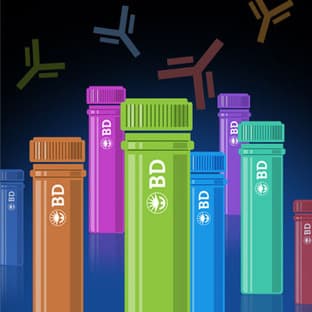
Supplier:
Boster ImmunoleaderCat no: PA1313
Polyclonal Anti-PUMA
Prices direct from Boster Immunoleader
Quick response times
Exclusive Absave savings/discounts
SPECIFICATIONS
Price
200.00 USD
Catalog Number
PA1313
Size
100ug/vial
Applications
WB
Reactivities
Hum, Mouse, Rat
Form
Lyophilized
Format
Each vial contains 5mg BSA, 0.9mg NaCl, 0.2mg Na2HPO4, 0.05mg Thimerosal, 0.05mg NaN3.
Gene Id
BBC3
References
1. Nakano K, Vousden KH (March 2001). \"PUMA, a novel proapoptotic gene, is induced by p53\". Mol. Cell 7 (3): 683
Swiss Prot
Q9BXH1
Storage Temp
\"At -20 degree C for one year. After reconstitution, at 4 degree C for one month. It can also be aliquotted and stored frozen at -20 degree C for a longer time.\nAvoid repeated freezing and thawing. \n\"\n
Additional Info
A synthetic peptide corresponding to a sequence at the C-terminal of human PUMA, identical to the related rat and mouse sequences.
Scientific Background
The p53 upregulated modulator of apoptosis, or PUMA, is a pro-apoptotic member of the Bcl-2 protein family. The PUMA gene is located at 19q. PUMA transcript is contained within 4 exons, with the presumptive initiation codon in exon 2. The predicted 193-amino acid PUMA protein shares 91% amino acid identity with the murine sequence. Bcl-2 family members can form hetero- or homodimers, and they act as anti- or pro-apoptotic regulators that are involved in a wide variety of cellular activities. The expression of PUMA is regulated by the tumor suppressor p53, and PUMA has been shown to be involved in p53-mediated apoptosis. Additionally, PUMA encodes 2 BH3 domain-containing proteins, PUMA-alpha and PUMA-beta, that are produced through the use of an alternative first exon and are induced in cells following p53 activation. Furthermore, PUMA couples the nuclear and cytoplasmic proapoptotic functions of p53.
More from Boster Immunoleader
Applications
WB
Reactivities
Hum
Applications
ELISA, WB
Reactivities
Hum
Applications
ELISA, IHC, WB
Reactivities
Hum
Applications
ELISA, WB
Reactivities
Mouse
Applications
ELISA, IHC, WB
Reactivities
Rat
Applications
BNI, ELISA, IHC, IP, WB
Reactivities
Mouse
Conjugates
Unconj, Agarose, AP, Biotin, Gold, HRP, BE, GE, YE, OE, RE, FRE, NIR, ONFC
Applications
BNI, ELISA, IHC, IP, WB
Reactivities
Rat
Latest promotions
Buy any polyclonal or monoclonal antibody from our extensive range of pre-made antibodies and for a limited time only receive a $50 discount!(T&C apply:...
New brilliant antibodies, and new lower prices!For flow cytometry reagents in general, \"bright is better.\" The violet-excitable BD Horizon™ BV421 and...
10% Discount on 2 Rabbit Polyclonal Antibody Service. With over 20 years experience, SDIX has developed into the premier US custom antibody producer,...
For the past decade scientists have extensively used ATS secondary toxin conjugates to make their own targeted toxins for in vitro use.The ability to combine...
We're so sure that you'll prefer Cayman Assay kits over your present brand that we're willing to give you a free assay kit to prove it!
Did your supplier increase the price of Fetal Bovine Serum? Did they substitute the US Origin with USDA? Well say no more! Innovative Research is still...
Bulk Cytokines with Custom Vialing.20 - 50% off cytokines, growth factors, chemokines and more...For a limited time Cell Sciences is offering substantial...
Are you planning to have a customised antibody made for your research?Since 2000, Everest has been producing a catalog containing thousands of affinity...
Top suppliers
Agrisera AB
11 products
Biotrend
Biosensis
969 products
ABBIOTEC
3011 products
SDIX
1 products
Spring Bioscience
2291 products
Cell Signaling Technology
4976 products
Rockland Immunochemicals, Inc.
7592 products
Boster Immunoleader
1533 products
OriGene Technologies Inc.
5281 products
Maine Biotechnology Services
227 products
BD (Becton, Dickinson and Company)
1 products
ABNOVA CORPORATION
Randox Life Sciences
1502 products















